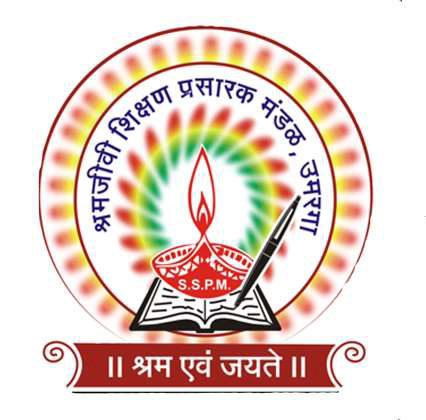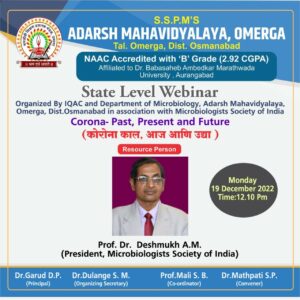|
About the Department
|
The
Department of Microbiology has been functioning since 1990, the foundation of
the institute. Ours is the only Microbiology department in Osmanabad
district among 20 colleges. It is one of the oldest departments with two
full-time teachers. The department offers Microbiology course at B.Sc. and
M.Sc. The department runs Certificate course of Fermented Food technology. Dr.
S. B. Mali (Professor and Head, Department of Microbiology Department) and
Dr. S. M. Dulange (Assistant Professor) have been recognized as Research
Supervisors by Dr. Babasaheb Ambedkar Marathwada University, Aurangabad,
(M.S). The
department holds an excellent record of good results, meritorious students, 9
research student are pursuing for Ph. D under the guidance of the faculties
working in the department and many students got qualified the competitive
examinations like NET/SET. The
department of Microbiology has a two well-equipped Laboratories with 3
computers, Projector, Internet Facility (Wi-Fi) and Smart-Board. Department
has its own departmental library with textbooks and references books as well. The
department has a very good collection of e-books as well. The department
conducts various programmes such as seminars, group discussion, projects, and
excursion tours for students. The
department organizes blood donation and blood group checking camps, guest
lectures of eminent teachers to update both the teacher and student
knowledge. The department celebrates the days like Teacher’s Day, Science
day, Aids day and birth days of scientists contributed to Microbiology. The
department provides consultancy services such as Microbiological testing of
Water samples, Antibiotic sensitivity testing, Operation theatre sterility
testing etc. |
|
Vision |
To be a center of excellence to produce
highly qualified and competent students in all areas of the Microbiology with
quality education, innovative research, and service emphases. |
|
Mission
|
To provide educational and research
programmes in various fields of microbiology and prepare students with
experimental learning to carry out creative, innovative and inventive
research and provide reliable services to the community. |
|
Aims and Objectives |
The aim of the Microbiology department
seeks to provide students with an education of the highest quality. We carry
out number of co-curricular and extracurricular activities along with
curriculum / prescribed syllabus. We anticipate proper discipline, sincerity,
good behavior, representation of ethics and protocols from each and every
student who seeks admission in our college. It seeks to attract the best
possible students from diverse geographical, professional, racial and ethnic
backgrounds. It encourages students throughout their programs so as to enable
them to progress expeditiously to their degrees and to gain the maximum
benefit from their experience. All students who have microbiology should
become comprehensive in all respects and therefore certain aims and
objectives have been formed by the department to proceed properly. They are: 1.
To offer courses within a college
program to enhance the intellectual foundation and preparation of students
for life in a complex, dynamic technological world. 2.
To prepare students for professional
schools, graduate education, for careers in clinical microbiology, and for
careers in basic, environmental and biomedical research. 3.
To prepare graduate students with
in-depth knowledge and research skills for professional careers in
Microbiology; 4.
To enhance opportunities for research
and scholarship for faculty members as well as undergraduate and graduate
students; 5.
To preserve, add to, evaluate, and
transmit knowledge in the field of Microbiology; and serve society by
promoting science in schools. 6.
Initiate, promote, develop and sustain
quality innovative research protocols in microbiology. 7.
To enhance collaborations and links with
other organizations of higher learning and the industry. 8.
To train and continually review and
develop curricula that meet the needs and expectations of
customers, and make them relevant and adaptable to the changing
needs in the discipline of microbiology. 9.
To provide a thorough and pure
microbiological knowledge on which practical applications and industrial
trainings are based. The graduates are trained for job opportunities in
Medical Laboratories, Biotechnological, Food and Pharmaceutical industries,
Breweries, Agricultural and Veterinary establishments, Research institutes,
Environmental Protection agencies and Educational institutions. 10. To provide practical training both in the
laboratory and industrial establishments prepare graduates to be
self-employed and even become employers of labour. 11. To provide a broad-based academic training
upon which graduates of programme can build to pursue higher degrees of
M.Sc., M.Phil / Ph.D in Microbiology. |
|
Future plans
|
|
Staff/Faculty
| Sr. No | Name Of Faculty | Designation | Photo | Contact |
| 1 | Dr. MALI SARJERAO BABARAO Qualification – M. Sc. Ph. D Resume | Professor & Head
|  | Email: Mobile: 9422558789 |
| 2 | Dr .SANJAY DULANGE Qualification – M. Sc. Ph. D | Assistant Professor |  | Email: Mobile: 8830993400 / 9421359551 |
Department offers
the following Programmes:
1. Undergraduate Studies (B. Sc.) Microbiology
2. Postgraduate Studies (M. Sc.) Microbiology
3. Research studies (Ph. D.) Microbiology
Certificate course
Fermented food technology
| Organizing Committee | About | Poster |
Dr. D.P.Garud Dr. Dulange S. M. Prof. Mali S. B. Dr. Mathpati S. P. Speaker:
| Total Registrations: 397 Feedbacks: 272 Certifications: 235
|
Webinar’s youtube link |
Activity | Year | Report |
Regional level seminar on Platelets and Blood Donation Awareness | 14 March 2018 | View |
One day workshop on “Advanced Techniques for Basic Sciences” | 16 February 2018 | View |
Class | Syllabus |
B.Sc. I Year | |
B.Sc. II Year | |
B.Sc. III Year | |
M. Sc. I Year | |
M. Sc. II Year |
Class | Semester | Paper No. & Course Code | Unit /Topic name |
Theory notes | |||
B. Sc. I Year | Sem. I | Paper No. I (MCB – 111) Fundamentals of Microbiology | Unit-I (History of Microbiology) |
Unit-II (Microscopy) | |||
Unit- III (Taxonomy of Microorganisms) | |||
|
|
|
|
B. Sc. I Year | Sem. I | Paper No. II (MCB – 112) Microbial Techniques | Unit-I (Sterilization) |
Unit-II (Sterilization & Disinfection) | |||
Unit-III (Pure Culture Techniques & Cultivation of Microorganisms) | |||
Unit-IV (Stains & Staining) | |||
|
|
|
|
B. Sc. I Year | Sem. II | Paper No. IV (MCB – 211) Microbial Chemistry | Unit-I (Basic of Atoms and Molecules) |
Unit-II (Amino acids & Proteins) | |||
Unit-III (Carbohydrates) | |||
Unit-IV (Lipids & Nucleic acids) | |||
|
|
|
|
B. Sc. I Year | Sem. II | Paper No. V (MCB – 212) Bacterial Cytology & Virology) | Unit-I (Bacterial Morphology and Outer ultra structures of cells) |
Unit-II (Bacterial Morphology and inner ultra structures of cells) | |||
Unit-III (Viral Morphology & Genomic structure) | |||
Unit-IV(Classification, Multiplication, Cultivation & Impact of viruses) | |||
|
|
|
|
Practical Journals / Record Books | |||
B. Sc. I Year | Annual Practical | Paper No. III (Lab. Course I) | |
Paper No. VI (Lab. Course II) | |||
Class | Semester | Paper No. & Course Code | Unit /Topic name |
Theory notes | |||
B. Sc. II Year | Sem. III | Paper No. VII Environmental Microbiology | Unit-I (Microbiology of air) |
Unit-II (Microbiology of Water and Waste water) | |||
Unit- III (Microbiology of Soil) | |||
Unit-IV (Environmental Pollution) | |||
|
|
|
|
B. Sc. II Year | Sem. III | Paper No. VIII Immunology | Unit-I (Normal Flora and Infection) |
Unit-II (Immune system and Immune responses) | |||
Unit-III (Immunity & Ag-Ab Structure) | |||
Unit-IV (Antigen – Antibody reactions, Vaccines) | |||
|
|
|
|
B. Sc. II Year | Sem. IV | Paper No. XI Applied Microbiology | Unit-I (Dairy Microbiology) |
Unit-II (Food Microbiology) | |||
Unit-III (Foodborne diseases and intoxication) | |||
Unit-IV (Fermented Food and Probiotics) | |||
|
|
|
|
B. Sc. II Year | Sem. IV | Paper No. XII Clinical Microbiology | |
Unit-II (Study of Human Diseases caused by Enteric bacteria and spirochete) | |||
Unit-III (Viral diseases) | |||
Unit-IV(Protozoal, Fungal diseases) | |||
|
|
|
|
Practical Journals / Record Books | |||
B. Sc. II Year | Annual Practical | Paper No. IX | |
Paper No. X | |||
Paper No. XIII | |||
Paper No. XIV | |||
Class | Semester | Paper No. & Course Code | Unit /Topic name | |
Theory notes | ||||
M. Sc. I Year | Sem. I | Paper No. I Biostatistics, Computer Applications and Research Methodology | Unit-I (Introduction to Biostatistics) | |
Unit-II (Measures of central tendency) | ||||
Unit- III (Tests of significance) | ||||
Unit-IV (Introduction to computers and computer applications) | ||||
Unit-V (Research Methodology) | ||||
|
|
|
| |
M. Sc. I Year | Sem. I | Paper No. II Bioenergetics and Enzymology | Unit-I (Carbohydrate catabolic pathways and microbial growth on C1Compounds) | |
Unit-II (Bacterial fermentations and Biosynthesis) | ||||
Unit-III (Endogenous metabolism and degradation of aliphatic and aromaticcompounds) | ||||
Unit-IV (Properties of Enzymes) | ||||
Unit- V (Enzyme kinetics) | ||||
|
|
|
| |
M. Sc. I Year | Sem. I | Paper No. III Bioinstrumentation Techniques and Applications
| Unit-I (Basic laboratory Instruments) | |
Unit-II (Chromatographic techniques) | ||||
Unit-III (Electrophoretic techniques) | ||||
Unit-IV (Spectroscopy) | ||||
Unit-V (Radio isotopictechniques) | ||||
|
|
|
| |
M. Sc. I Year | Sem. I | Paper No. IV Industrial Food and Dairy Microbiology
| Unit-I (Industrial Food fermentations) | |
Unit-II (Industrial Dairy fermentations) | ||||
Unit-III (Advanced Food and dairy Microbiology) | ||||
Unit-IV(Food preservation methods and utilization of dairy waste) | ||||
Unit-V (Food spoilage and Quality assurance) | ||||
|
|
|
| |
Practical Journals / Record Books | ||||
M. Sc. I Year | Sem. I | Paper No. I | Paper No. I (Biostatistics, Computer Applications and Research Methodology) | |
Paper No. II | Paper No. II(Bioenergetics and Enzymology) | |||
Paper No. III | Paper No. III(Bioinstrumentation Techniques and Applications) | |||
Paper No. IV | Paper No. IV(Industrial Food and Dairy Microbiology) | |||
Class | Semester | Paper No. & Course Code | Unit /Topic name | |
Theory notes | ||||
M. Sc. I Year | Sem. II | Paper No. V Recent Trends in Virology | Unit-I (Classification and Morphology of Viruses) | |
Unit-II (Cultivation and assay of viruses) | ||||
Unit- III (Introduction to virus transmission and Multiplication) | ||||
Unit-IV (Pathogenesis of Viruses) | ||||
Unit-V (Control of Viruses and Emerging Viruses) | ||||
|
|
|
| |
M. Sc. I Year | Sem. II | Paper No. VI Molecular Immunology | Unit-I (Immune System) | |
Unit-II (Antigens and Immunoglobulins) | ||||
Unit-III (Antigen – Antibody reactions) | ||||
Unit-IV (Expression and Regulation of Immune Response) | ||||
Unit- V (Immunity and Immunoassays) | ||||
|
|
|
| |
M. Sc. I Year | Sem. II | Paper No. VII Microbial Physiology | Unit-I (Photosynthesis) | |
Unit-II (Bacterial Respiration) | ||||
Unit-III (Bacterial Permeation) | ||||
Unit-IV (Bacterial Sporulation) | ||||
Unit-V (Bacterial Chemolithotrophy and Nitrogen Metabolism) | ||||
|
|
|
| |
M. Sc. I Year | Sem. II | Paper No. VIII Microbial Diversity and Extremophiles | Unit-I (Biodiversity) | |
Unit-II (Ecology) | ||||
Unit-III (Characteristics and classification of Archaebacteria) | ||||
Unit-IV(Alkalophiles and Acidophiles) | ||||
Unit-V (Halophiles and Barophiles) | ||||
|
|
|
| |
Practical Journals / Record Books | ||||
M. Sc. I Year | Sem. II | Paper No. V | Paper No. V(Recent Trends in Virology) | |
Paper No. VI | Paper No. VI(Molecular Immunology) | |||
Paper No. VII | Paper No. VII(Microbial Physiology) | |||
Paper No. VIII | Paper No. VIII(Microbial Diversity and Extremophiles) | |||
Class | Semester | Paper No. & Course Code | Unit /Topic name | |
Theory notes | ||||
M. Sc. II Year | Sem. III | Paper No. IX Enzyme Technology | Unit-I (Extraction and Purification of Microbial Enzymes) | |
Unit-II (Enzyme Inhibition and kinetics) | ||||
Unit- III (Immobilization of enzymes) | ||||
Unit-IV (Enzyme / Protein Engineering) | ||||
Unit-V (Clinical Enzymology) | ||||
|
|
|
| |
M. Sc. II Year | Sem. III | Paper No. X Bioprocess Engineeringand Technology | Unit-I (Introduction to Industrial Bioprocess Engineering) | |
Unit-II (Bioreactors) | ||||
Unit-III (Mass Transfer and Sterilization) | ||||
Unit-IV (Upstream processes) | ||||
Unit- V (Down Stream Process) | ||||
|
|
|
| |
M. Sc. II Year | Sem. III | Paper No. XI MolecularMicrobial Genetics | Unit-I (Molecular Structure Of Chromosome) | |
Unit-II (Molecular mechanism of gene expression) | ||||
Unit-III (Regulation Of Gene Expression) | ||||
Unit-IV (Transposable Elements and Recombination) | ||||
Unit-V (Genetics Of Viruses) | ||||
|
|
|
| |
M. Sc. II Year | Sem. III | Paper No. XII Environmental MicrobialTechnology | Unit-I (Environment and Ecosystems) | |
Unit-II (Eutrophication) | ||||
Unit-III (Effluent treatment techniques) | ||||
Unit-IV(Bioremediation of Xenobiotics) | ||||
Unit-V (Global environmental problems) | ||||
|
|
|
| |
Practical Journals / Record Books | ||||
M. Sc. II Year | Sem. III | Paper No. IX | Paper No. IX (EnzymeTechnology) | |
Paper No. X | Paper No. X (Bioprocess Engineeringand Technology) | |||
Paper No. XI | Paper No. XI (MolecularMicrobialGenetics) | |||
Paper No. XII | Paper No. XII (EnvironmentalMicrobialTechnology) | |||
Class | Semester | Paper No. & Course Code | Unit /Topic name | |
Theory notes | ||||
M. Sc. II Year | Sem. IV | Paper No. XIII Recombinant DNA Technology | Unit-I (Enzymes And Basic Techniques Used In rDNA Technology) | |
Unit-II (Advanced Techniques In rDNA Technology) | ||||
Unit- III (Cloning Vectors) | ||||
Unit-IV (Gene Cloning Techniques) | ||||
Unit-V (Applications Of Genetic Engineering) | ||||
|
|
|
| |
M. Sc. II Year | Sem. IV | Paper No. XIV Fermentation Technology | Unit-I (Microbial Fermentations) | |
Unit-II (Microbial production of therapeutic compounds) | ||||
Unit-III (Modern trends in microbial production) | ||||
Unit-IV (Biofuels and Plant Tissue Culture) | ||||
Unit- V (IPR and Patents) | ||||
|
|
|
| |
M. Sc. II Year | Sem. IV | Paper No. XV Bioinformatics, Microbial Genomics and Proteomics | Unit-I (Bioinformatics and its Applications) | |
Unit-II (Whole Genome Analysis) | ||||
Unit-III (Sequence Analysis) | ||||
Unit-IV (DNA – Microarray) | ||||
Unit-V (Proteomics) | ||||
|
|
|
| |
M. Sc. II Year | Sem. IV | Paper No. XVI Pharmaceutical Microbiology | Unit-I (Antibiotics Vitamins, and enzymes) | |
Unit-II (Aspects of large-scale Vaccine manufacturing) | ||||
Unit-III (Microbial control aspects in pharmaceutical Industry) | ||||
Unit-IV(Sterilization procedures and sterility assurance) | ||||
Unit-V (Quality Aspects and Regulatory Policies in Pharmaceutical Industries) | ||||
|
|
|
| |
Practical Journals / Record Books | ||||
M. Sc. II Year | Sem. IV | Paper No. XIII | Paper No. XIII (Recombinant DNA Technology) | |
Paper No. XIV | Paper No. XIV (Fermentation Technology) | |||
Project Paper No. XVII | Project Paper No. XVII (Project 1) (Project 2) | |||


